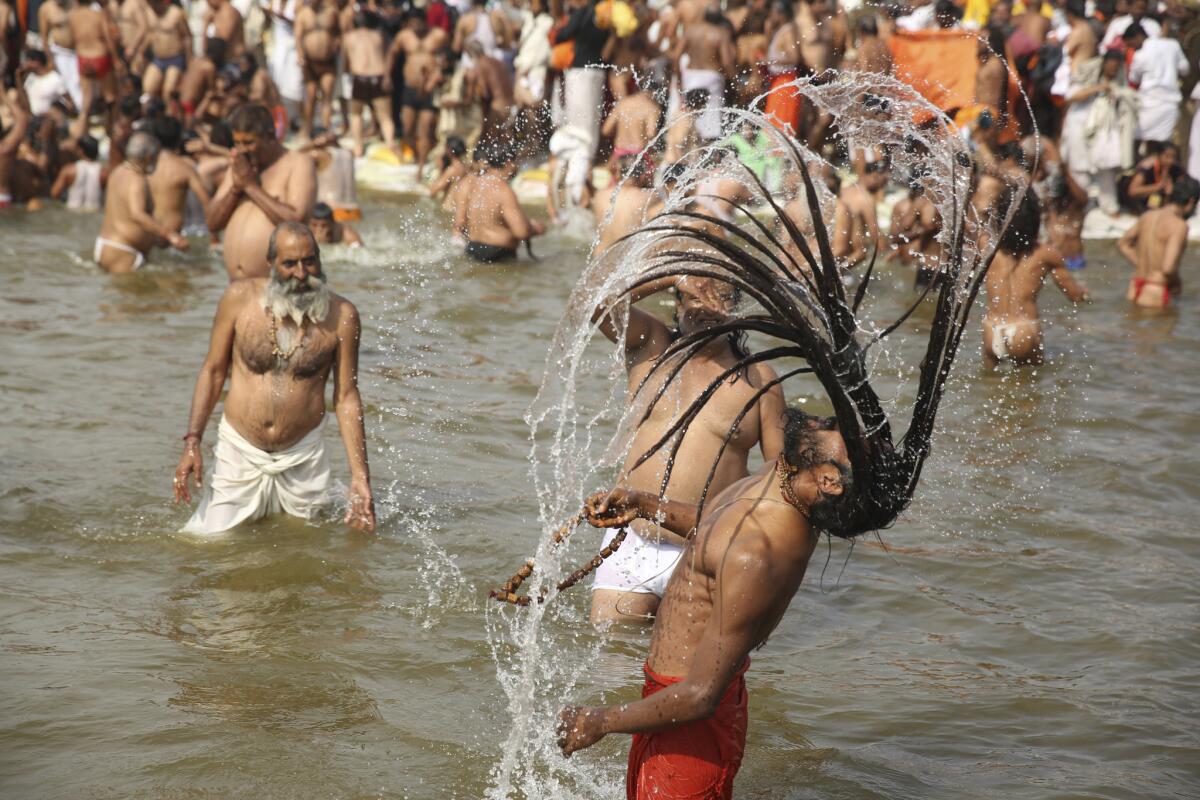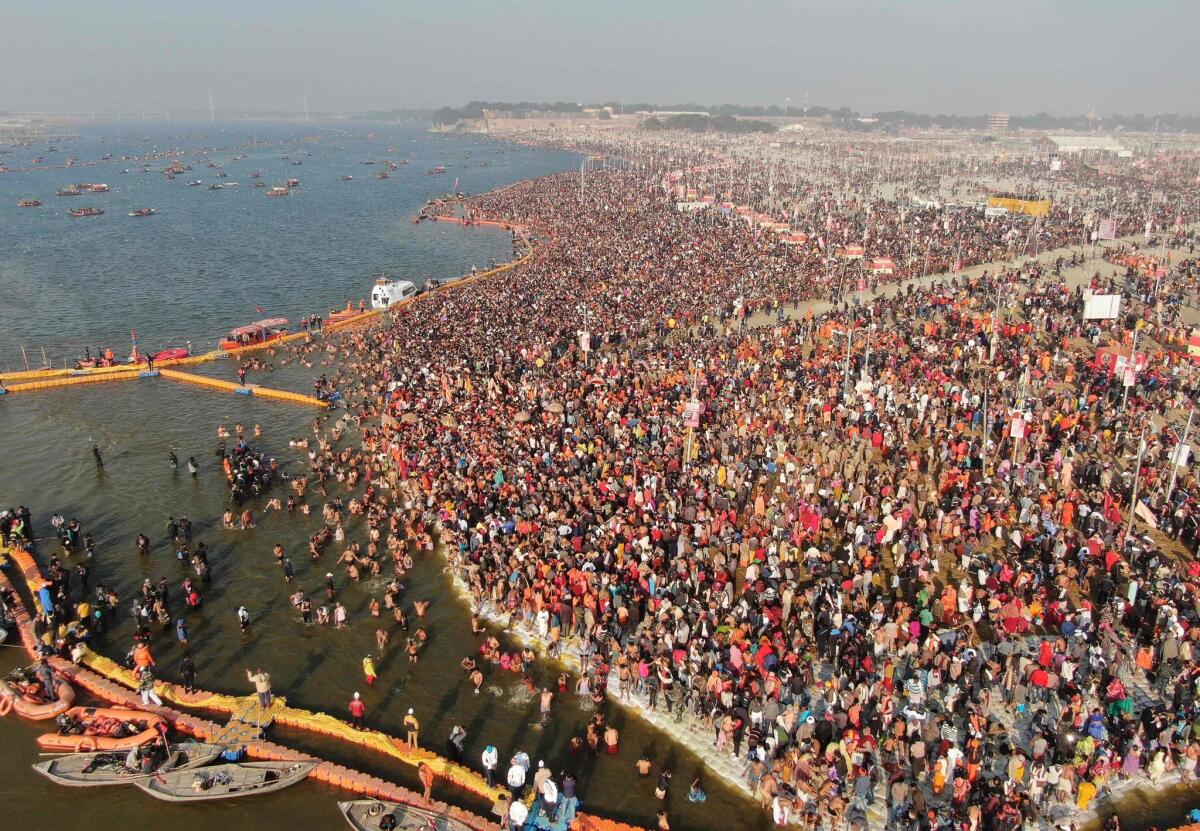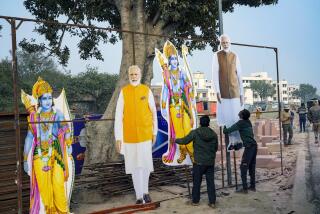Review: ‘Ganges’ explores why the river draws pilgrims and emperors alike to dip in its sacred waters

Over the next few weeks, more than 120 million people will converge at the confluence of three rivers, the Ganges, the Yamuna and the mythical Sarasvati, in the northern Indian city of Prayagraj for a Hindu pilgrimage. This year’s Kumbh Mela is expected to be one of the largest-ever gatherings of people in history. Devout Hindus travel from all over the world for the pilgrimage, packing into a 15-square-mile temporary town built within the ancient city previously known as Allahabad until a name change in 2018, waiting for a turn to take a ritual dip in what many consider one of the holiest places along the holiest of rivers.
Accounts of India by British colonials and foreign contemporary writers alike have highlighted the contrasts — or contradictions, as some would have it — embodied by the Ganges and its place in the firmament of the Hindu gods and religious belief. The river, considered the earthly embodiment of Vishnu, is where devout Hindus go to be blessed and where they go to die. If being cremated on its banks is not an option, then taking a pilgrimage to dip in its waters can suffice for a lifetime. But outsiders often balk at the notion that such polluted water can offer anything approaching salvation.

“The Hindus counted their beads and prayed, made ritual gestures, ducked under the sacred slime, drank, and were moved on by the police to make room for another installment of the patient million,” Aldous Huxley wrote in his 1926 travel journal, “The Jesting Pilate” of the scene at the ghats — the stairs leading to the waterway — alongside the river in the ancient city of Varanasi. But if India’s British colonizers were often dismissive of the mass pilgrimages to the river, they were in their own way in awe of its water.

Ganges water was a beverage of choice in the 16th and 17th centuries for sailors making their way from India to the Netherlands or England. Water from the river simply didn’t go bad, even when it was packed away in the hold of a ship for months on end. Emperor Akbar, who ruled Mughal India in the 16th and early 17th centuries, felt similarly, and he supposedly drank water only from the Ganges. Not only would water from the Ganges keep on a long sea voyage but it also has the profound chemical ability to cleanse. As UC Davis history professor Sudipta Sen details in “Ganges: The Many Pasts of an Indian River,” cholera microbes have a 48-hour lifespan in distilled water, but persist for just three in the river’s waters, thanks to high levels of a bacteria-killing virus called bacteriophage.
“The Ganga as a deity is very much alive to this day.”
— Sudipta Sen
If there’s a contradiction, it’s that there’s some scientific basis to the belief in the Ganges’ curative powers. It’s one of many examples of faith and myth overlapping with reality that Sen examines in “Ganges,” an all-encompassing history of the river, its ecologies and the people who have lived alongside it for millenniums. In examining the traditions of animism that are at the foundation of Buddhism, Hinduism and Jainism alike — not to mention the raw power of the rushing river to both give life and violently take it away — Sen shows how it has played an integral role in shaping the geography, economy and spiritual life of civilization across the 300,000 square miles of the Ganges plain and throughout thousands and thousands of years. The river might not be a god, but it can certainly appear like one at times.
Sen begins by differentiating Vedic myths from the archaeological record, detailing what life likely looked like in the upper Ganges going back into the second millennium BC. Much of the concrete detail is extrapolated from the various layers of pottery shards and metal fragments found in mounds along the river’s edge. The relatively younger age of iron tools found at archaeological sites pushes and pulls on many facets of the the long-accepted narratives of epics like the Ramayana and the Bhagavad Gita, ultimately telling a more complicated, more true story of the prehistory on the Ganges plain. But as there are more historical accounts to rely on as various kingdoms were built up and battled over control of the river, the details of dynasty, war and succession bog down Sen’s writing. Snipped narratives of the various kingdoms that fought through the first 1,000 or so years of the common era dominate this middle section, and time (rather necessarily) passes too quickly as Sen details the rise and fall of dynastic rulers in the space of a few pages.
Maybe it’s the stasis of the centuries-long rule of the Mughal emperors, or the outsize influence of both Akbar and the East India Co., but the book picks back up in age of empires, a time during which the Ganges, as always, was a lifeblood. “Over centuries,” Sen writes, “this watercourse has generated a surplus that not only supported the great agrarian empires of the distant past but also underwrote the mighty industrial empire of Victorian Britain.” Today, as the river has increasingly been harnessed both for hydroelectric power and complex irrigation systems, along with supplying water to half a billion people, it continues to shape India in a significant material way.
But for all the dams and channels and bridges that both leverage and potentially destroy the highly polluted river, Sen’s contention from early in the book seems to remain true: “The Ganga as a deity is very much alive to this day.”
::
“Ganges: The Many Pasts of an Indian River”
Sudipta Sen
Yale University Press; 464 pp., $30
Blackmore is a freelance journalist who covers food, culture and the environment. He lives in Maine.
More to Read
Sign up for our Book Club newsletter
Get the latest news, events and more from the Los Angeles Times Book Club, and help us get L.A. reading and talking.
You may occasionally receive promotional content from the Los Angeles Times.






